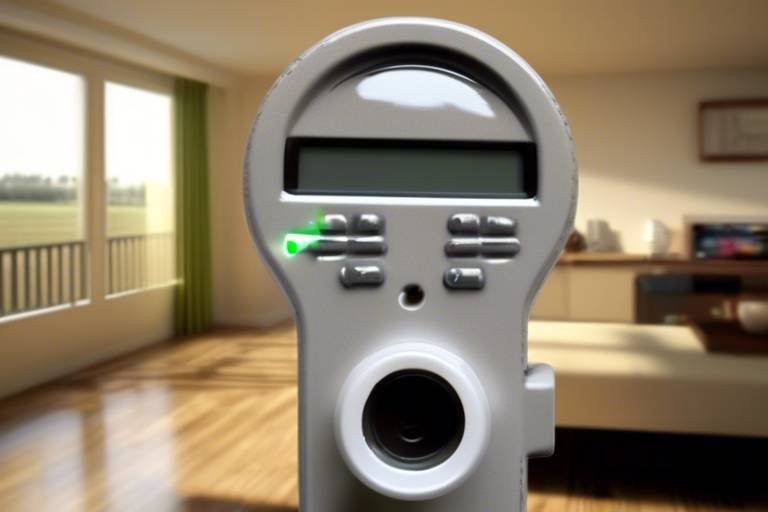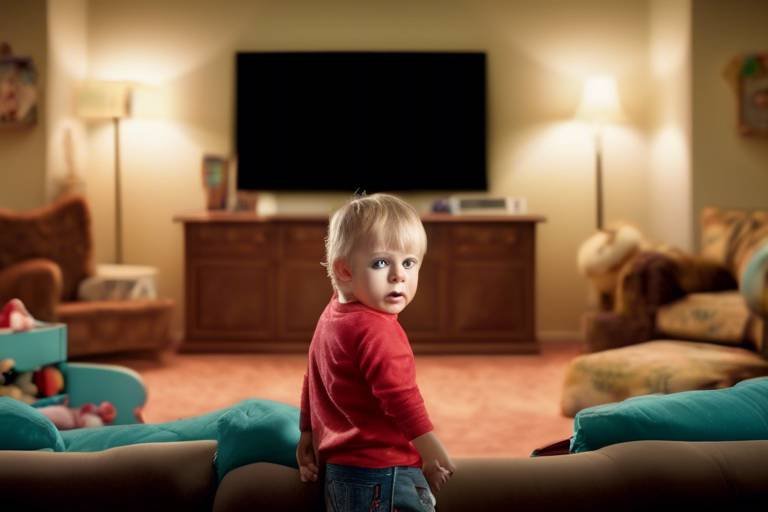Creating Safe Spaces for Autistic Children at Home
Creating a nurturing environment for autistic children is more than just a design choice; it's a vital part of their development and well-being. The home should be a sanctuary where they feel safe, secure, and understood. Autistic children often navigate a world filled with sensory overload and emotional challenges, making it essential for parents and caregivers to craft spaces that cater specifically to their unique needs. In this article, we will explore effective strategies to transform your home into a haven that promotes comfort, independence, and emotional security for your child.
One of the most important aspects of creating a safe space for autistic children is understanding their sensory needs. Many autistic children experience heightened sensitivities to sound, light, touch, and other sensory inputs. This can lead to overwhelming feelings, making it crucial to minimize overstimulation in their environment. For instance, if your child is sensitive to noise, consider soundproofing their room or using soft background music to create a calming atmosphere. Additionally, recognizing their preferences for different textures and materials can help you choose appropriate bedding, toys, and furnishings that promote relaxation.
Designing a calming environment can significantly benefit autistic children. The colors, lighting, and arrangement of furniture all play a critical role in creating a soothing atmosphere conducive to their well-being. By making strategic choices in these areas, you can help your child feel more at ease in their surroundings.
The colors used in a child's room can dramatically influence their mood and behavior. Choosing soft, muted tones like pale blues, greens, and lavenders can help create a peaceful space that reduces anxiety and promotes focus. Bright, bold colors may be stimulating and could lead to feelings of agitation. When selecting colors, think of them as the palette of emotions—the right shades can calm the storm within.
Proper lighting is essential for sensory comfort. Natural light can uplift spirits, while harsh fluorescent bulbs can create discomfort. Consider using adjustable lighting options, such as dimmers and lamps with warm bulbs, to tailor the brightness to your child's needs. Blackout curtains can also be beneficial, allowing you to control the amount of light entering the room, making it easier for your child to relax or sleep.
The layout of furniture can impact a child's sense of security. A room with open spaces can feel overwhelming, while cozy nooks can provide a sense of safety. Think about creating a balance between open areas for play and quiet corners for retreat. A well-thought-out arrangement can make all the difference in how your child interacts with their environment.
Sensory tools can aid in self-regulation and comfort for autistic children. Items like fidget toys, weighted blankets, and sensory bins can enhance their home experience. These tools can provide an outlet for excess energy and help them manage overwhelming feelings. For example, a weighted blanket can offer a sense of security and calmness, while a sensory bin filled with rice or sand can provide tactile stimulation that soothes their senses.
Routines provide structure and predictability, which are essential for autistic children. Establishing a daily schedule helps create a sense of normalcy and can significantly reduce anxiety. By implementing consistent routines, you empower your child to navigate their day with confidence.
Visual schedules can be a game-changer for children who thrive on structure. These aids help children understand their daily tasks and transitions. You can create a simple visual schedule using pictures or icons that represent different activities throughout the day. This not only makes the routine more engaging but also caters to various learning styles, making it easier for your child to follow along.
Transitions can be particularly challenging for autistic children. To ease these moments, consider using countdown timers or verbal cues to signal upcoming changes. For example, if it's time to switch from play to dinner, giving a five-minute warning can help your child prepare for the change. This simple strategy can make transitions smoother and less stressful for both children and parents.
Safe zones within the home can provide children with a retreat when feeling overwhelmed. Designating a specific area as a safe zone allows your child to have a space they can go to when they need a break. This could be a corner filled with soft pillows, calming colors, and their favorite sensory tools. By decorating these spaces with their preferences in mind, you create a comforting environment that promotes emotional regulation and peace.
- What are sensory tools, and how can they help my child?
Sensory tools are items designed to provide sensory stimulation or calmness. They can help autistic children with self-regulation and emotional comfort. - How can I create a visual schedule for my child?
You can create a visual schedule using pictures or icons representing daily activities. Display it in a prominent place for easy reference. - What colors should I avoid when designing my child's room?
Avoid bright, bold colors that may be overstimulating. Opt for soft, muted tones instead. - How can I help my child with transitions?
Use countdown timers or verbal cues to signal transitions. Providing warnings can help them prepare for changes.

Understanding Sensory Needs
When it comes to creating a nurturing environment for autistic children, understanding their sensory needs is absolutely crucial. Many autistic children experience heightened sensitivities to sensory input, which means that everyday stimuli—like sounds, lights, and textures—can feel overwhelming. Imagine walking into a crowded, noisy room with bright lights flickering; that’s how some autistic children might feel in a typical environment. By recognizing and accommodating these sensory sensitivities, we can create a home that feels safe and comfortable.
To begin with, let’s delve into what sensory needs entail. Sensory processing refers to how the brain interprets and responds to sensory information from the environment. For autistic children, this processing can be either heightened or diminished. For example, while some children may be overwhelmed by loud noises, others might seek out intense sensory experiences, like spinning or jumping. This variability means that every child is unique, and understanding their specific sensory profile is essential.
Here are some common sensory sensitivities that parents should be aware of:
- Auditory Sensitivity: Some children may react negatively to loud sounds, such as vacuum cleaners or sirens, while others may enjoy certain music or rhythmic sounds.
- Visual Sensitivity: Bright lights or busy patterns can be distracting or distressing, making it important to choose calming visuals in their environment.
- Tactile Sensitivity: Textures can be a big deal. Some children may dislike certain fabrics or materials, while others may find comfort in weighted blankets or soft toys.
Understanding these sensitivities is just the first step. The next challenge is to create an environment that minimizes overstimulation. This can involve simple changes around the home. For instance, using soundproofing materials can help reduce auditory distractions, while soft, muted colors can create a more visually soothing space. It’s also beneficial to provide options for sensory input, such as fidget toys or sensory bins filled with various textures, to help children self-regulate when they feel overwhelmed.
Ultimately, the goal is to foster a sense of emotional security and comfort. Creating a safe space where autistic children can express themselves and manage their sensory experiences can significantly improve their overall well-being. By paying attention to their unique sensory needs, we not only support their development but also empower them to thrive in their home environment.

Designing a Calming Environment
Creating a calming environment for autistic children is more than just a design choice; it's a vital aspect of their well-being. When we think about home as a sanctuary, it should be a place where they can thrive without feeling overwhelmed. The right environment can make all the difference, turning a chaotic space into a haven of peace and comfort. So, how do we achieve this? By focusing on color schemes, lighting options, and furniture arrangements that cater to their unique sensory needs.
The colors we choose for a child's room can have a profound impact on their mood and behavior. Bright, bold colors might seem fun, but for many autistic children, they can be overstimulating. Instead, opting for soft, muted tones can create a peaceful atmosphere that helps reduce anxiety and promotes focus. Think about colors like pastel blues, gentle greens, and soft yellows. These hues not only evoke feelings of calmness but also encourage a sense of security. Imagine walking into a room painted in soothing colors; it feels like a warm embrace, doesn’t it?
Next up is lighting. Proper lighting is essential for sensory comfort. Natural light is a fantastic option, as it creates a connection to the outside world while providing a gentle glow. However, not all homes are blessed with ample sunlight, so adjustable lighting becomes crucial. Consider using dimmer switches or soft LED lights that can be adjusted based on the time of day or the child's mood. Additionally, blackout curtains can be a game-changer for those moments when the sun is just too bright. A well-lit room should feel like a cozy cocoon, allowing children to relax and recharge.
The layout of furniture plays a significant role in how safe and secure a child feels in their space. An open layout can promote freedom and movement, while cozy nooks can provide a sense of retreat. Think about creating designated areas within the room—perhaps a reading corner with a comfy chair and soft pillows, or a quiet space with a weighted blanket where they can unwind. The goal is to strike a balance between open spaces for play and cozy spots for relaxation. A well-thought-out arrangement can help children feel both invited and protected in their environment.
In addition to colors, lighting, and furniture, incorporating sensory tools into the environment can significantly enhance comfort and self-regulation. Tools like fidget toys, weighted blankets, and sensory bins can provide the necessary support for autistic children to navigate their emotions and sensory experiences. For instance, a sensory bin filled with rice or sand can offer a tactile experience that soothes and engages. These tools can transform a simple room into a dynamic space that caters to the child's sensory preferences, making home feel like a personalized haven.

Color Choices
When it comes to designing a space for autistic children, the colors we choose can have a profound impact on their mood and behavior. Imagine walking into a room painted in vibrant reds and yellows; while these colors might energize some, they can overwhelm an autistic child, leading to anxiety or sensory overload. Instead, opting for soft, muted tones can create a peaceful haven that fosters relaxation and focus. Think of colors like gentle blues, soft greens, and warm neutrals—these hues can act like a soothing balm, calming the senses and creating a sense of safety.
In addition to the basic color palette, it's essential to consider the psychological effects of colors. For example:
- Blue: Known for its calming effects, blue can help lower heart rates and reduce feelings of anxiety.
- Green: This color is often associated with nature and can promote a sense of balance and harmony.
- Yellow: While it can be cheerful, it’s important to use it sparingly, as too much yellow can be overstimulating.
Furthermore, the placement of colors matters too. A room with a color gradient can create a sense of flow and tranquility. For instance, painting the lower half of the walls in a soft green and the upper half in a light blue can visually ground the space while still allowing it to feel airy and open. This technique can help in reducing feelings of confinement, which is often a concern for autistic children.
It's also worth considering the furniture and decor in relation to color. Using complementary colors for furniture can enhance the overall aesthetic while maintaining a calming environment. For example, pairing a soft blue wall with light wood furniture can create a harmonious and inviting atmosphere. Additionally, incorporating colorful yet soothing artwork can stimulate creativity without overwhelming the senses. Remember, it’s all about finding that perfect balance!
In conclusion, the colors we choose for an autistic child's room can significantly influence their emotional and sensory experience. By selecting soft, calming shades and being mindful of how colors interact with each other, we can create a nurturing environment that promotes comfort and independence. After all, a well-designed space can be a powerful ally in supporting the unique needs of autistic children.
Q: What colors are best for an autistic child's room?
A: Soft, muted tones like gentle blues, greens, and warm neutrals are generally the best choices. These colors can help create a calming environment.
Q: How can I incorporate color without overwhelming my child?
A: Use a limited color palette and consider adding accents through decor items, such as pillows or artwork, rather than painting the walls in bright colors.
Q: Are there specific color combinations to avoid?
A: Yes, colors like bright red or neon shades can be overstimulating for many autistic children, so it's best to avoid them in large areas.

Lighting Solutions
When it comes to creating a safe space for autistic children, play a pivotal role in shaping their overall comfort and well-being. The right lighting can transform a room, making it more inviting and calming. For many autistic children, harsh fluorescent lights can feel overwhelming, leading to anxiety and discomfort. Therefore, it's essential to consider lighting options that cater to their unique sensory needs.
One of the most effective strategies is to maximize natural light. Sunlight has a soothing effect and can help regulate mood. If possible, try to position furniture in a way that allows the sunlight to stream in during the day. However, too much light can also be a problem, so incorporating blackout curtains can provide a quick solution for when it’s time to wind down. These curtains help block out excess light, creating a more tranquil environment for relaxation and sleep.
Another important aspect to consider is the use of adjustable lighting. This can include dimmer switches or lamps with adjustable brightness. By allowing your child to control the light levels, you empower them to create their own comfortable atmosphere. For instance, during playtime, brighter lights may be invigorating, while softer, warmer lights can be more suitable for winding down or bedtime routines. A combination of both may be ideal, offering flexibility based on the time of day or activity.
Additionally, consider using soft, warm light bulbs instead of harsh white ones. These can create a cozy atmosphere that feels safe and inviting. LED lights with adjustable color temperatures can also be beneficial, as they allow for a spectrum of light that can be tailored to your child's preferences. For example, some children may respond positively to soft blue hues, while others might prefer gentle yellows or warm whites.
Lastly, creating a lighting schedule can help establish routines. Just as you might have a set time for meals or play, having a consistent lighting pattern can signal to your child when it's time to be active versus when it's time to relax. This can be particularly helpful in easing transitions, as your child will begin to associate certain lighting with specific activities.
In conclusion, the right lighting solutions can significantly enhance the comfort and security of a space for autistic children. By focusing on natural light, adjustable options, and warm tones, you can create an environment that not only meets their sensory needs but also fosters a sense of independence and calm.
- What types of lighting are best for autistic children? Soft, warm lighting with adjustable brightness is often best, as it can help reduce overstimulation.
- How can I create a calming atmosphere with lighting? Use natural light during the day, blackout curtains at night, and consider using dimmable lamps to adjust the mood based on activities.
- Are there specific light colors that are more soothing? Many find that soft blue or warm yellow tones are calming, but it's essential to observe your child's individual preferences.
- Can lighting help with transitions between activities? Yes, establishing a lighting schedule can signal to your child when it’s time to switch activities, creating a smoother transition.

Furniture Arrangement
When it comes to creating a nurturing environment for autistic children, plays a pivotal role in enhancing their sense of security and comfort. Imagine walking into a room where everything feels just right—where the layout invites exploration and relaxation. The way furniture is positioned can either promote a sense of openness or create cozy, safe corners that provide a retreat when things get overwhelming.
One of the first things to consider is the flow of movement within the space. Open spaces allow for easier navigation, especially for children who may be sensitive to feeling trapped or confined. By arranging furniture to create clear pathways, you can help your child feel more in control of their environment. For instance, placing a sofa against the wall can free up central space for movement, while still allowing for a cozy gathering area. This setup encourages children to explore without the fear of bumping into obstacles.
On the other hand, cozy nooks can be incredibly beneficial for moments when your child needs to retreat from sensory overload. Consider adding a small tent or a bean bag chair in a corner, surrounded by soft pillows and calming décor. This can serve as a personal sanctuary where they can unwind with their favorite book or sensory tool. The key is to strike a balance between open areas and these intimate spaces, ensuring that your child has options depending on their mood and needs.
Moreover, the height and type of furniture can also affect how safe a child feels. For example, selecting low, stable furniture reduces the risk of injury and creates a more inviting atmosphere. Using soft materials and rounded edges can further enhance safety. Incorporating elements like soft rugs can also provide comfort underfoot, making the space feel warm and welcoming.
Lastly, it’s essential to involve your child in the design process. Ask for their input on how they want their room to feel. This not only empowers them but also ensures that the space reflects their personality. Remember, the goal is to create a space where they feel safe, comfortable, and able to express themselves freely.
- What is the best way to arrange furniture for an autistic child?
Focus on creating open pathways for movement while also incorporating cozy spaces for retreat. Involve your child in the process to ensure the setup meets their needs. - How can I make my child's room more sensory-friendly?
Use soft, muted colors, comfortable furniture, and sensory tools. Consider adding rugs and soft furnishings to enhance comfort. - Should I prioritize open spaces or cozy nooks in my child's room?
Both are important. Open spaces allow for movement, while cozy nooks provide safe retreats. A balanced approach is best.

Incorporating Sensory Tools
When it comes to creating a nurturing environment for autistic children, sensory tools play a pivotal role. These tools are not just toys; they are essential instruments that can help children manage their sensory needs and find comfort in their surroundings. Imagine a world where a child can calm their racing thoughts or soothe their overstimulated senses simply by reaching for a weighted blanket or a fidget spinner. That's the power of sensory tools!
First up, we have fidget toys. These small, handheld devices can be a game-changer for children who need to keep their hands busy. Whether it's a squishy ball or a textured bracelet, these toys help channel nervous energy and can even improve focus during homework or quiet time. The beauty of fidget toys is that they come in various shapes, sizes, and textures, making it easy to find one that resonates with your child's unique preferences.
Next, let’s talk about weighted blankets. These blankets provide gentle pressure, which can mimic the sensation of being hugged. For many autistic children, this can be incredibly comforting, helping to reduce anxiety and promote a sense of security. Think of it as a cozy cocoon that wraps them in warmth and calmness. When selecting a weighted blanket, it's essential to choose one that is appropriate for your child's weight—typically around 10% of their body weight is a good rule of thumb.
Another fantastic sensory tool is the sensory bin. This is essentially a container filled with various materials—think rice, beans, or sand—that children can explore with their hands. Sensory bins are excellent for encouraging tactile exploration and can be tailored to suit your child's interests. For example, a dinosaur-themed sensory bin filled with sand and toy dinosaurs can provide hours of engaging play while also allowing for sensory exploration. The best part? You can change the contents of the bin based on your child's mood or sensory needs, keeping the experience fresh and exciting.
To help you visualize some of these tools, here's a simple table outlining a few popular sensory tools and their benefits:
| Sensory Tool | Benefits |
|---|---|
| Fidget Toys | Helps manage nervous energy and improves focus. |
| Weighted Blankets | Provides comfort and reduces anxiety through gentle pressure. |
| Sensory Bins | Encourages tactile exploration and imaginative play. |
Incorporating these sensory tools into your child's daily routine can create a more harmonious home environment. It's all about understanding what works best for your child and being open to trying new things. Remember, the goal is to provide a safe and supportive space where they can thrive. So, don’t hesitate to experiment with different tools and see what resonates with your little one!
- What are sensory tools? Sensory tools are items designed to help individuals manage their sensory needs, providing comfort and promoting self-regulation.
- How do I choose the right sensory tools for my child? Observe your child's preferences and sensory sensitivities, then select tools that cater to their unique needs.
- Can sensory tools help with anxiety? Yes, many sensory tools, like weighted blankets and fidget toys, can help reduce anxiety by providing comfort and a sense of security.

Establishing Routines
Routines are not just a series of tasks; they are the backbone of a structured day for autistic children. Imagine waking up every day to a predictable schedule that not only eases anxiety but also fosters a sense of independence. Establishing routines can transform chaos into a harmonious flow, allowing children to navigate their day with confidence. By providing a clear framework, routines help children understand what to expect, reducing the stress that often accompanies uncertainty. But how do we go about creating these effective daily schedules?
First, it's essential to consider the unique needs and preferences of your child. Every child is different, and what works for one may not work for another. Begin by involving your child in the planning process. This not only empowers them but also gives you valuable insights into their interests and comfort levels. For instance, if your child enjoys certain activities, such as drawing or playing outside, make sure to incorporate these into their daily routine. This can be done through a simple visual schedule that outlines their day.
Speaking of visual schedules, they are a fantastic tool for helping children understand their daily tasks. These can be created using pictures, symbols, or even color coding to represent different activities. For example, you could use a sun symbol for outdoor playtime and a book icon for reading time. Visual schedules cater to various learning styles, making it easier for children to grasp what’s coming next. When they can see their day laid out in front of them, it reduces anxiety and sets clear expectations.
Transitions can be particularly challenging for autistic children. Moving from one activity to another can create feelings of discomfort or distress. To ease these transitions, consider implementing a countdown system. For example, you might announce, “In five minutes, we will start our drawing time!” This gives your child a heads-up and prepares them for the change. You can even use a timer as a visual cue to signal the end of one activity and the beginning of another.
To further enhance the routine, consistency is key. Try to keep the daily schedule as similar as possible from day to day. This doesn’t mean there can’t be any flexibility—life is unpredictable—but having a consistent framework allows children to feel secure. You can also use a chart to track their progress and celebrate small achievements, which can be incredibly motivating. For example, you might have a sticker chart where they earn a sticker for completing their morning routine, reinforcing positive behavior.
Finally, remember that establishing routines is an ongoing process. It may take time for your child to adjust, and there will be days when things don’t go as planned. That’s perfectly okay! The goal is to create a supportive environment where your child feels safe and understood. With patience and practice, routines can become a powerful tool in helping your child thrive.
- Why are routines important for autistic children? Routines provide structure and predictability, which can help reduce anxiety and foster independence.
- How can I create a visual schedule? You can use pictures, symbols, or color coding to represent different activities throughout the day.
- What if my child resists the routine? Involve your child in the planning process and be flexible. It may take time for them to adjust.
- How can I make transitions easier? Use countdowns and visual cues, such as timers, to prepare your child for changes in activities.

Visual Schedules
Visual schedules are an incredibly effective tool for helping autistic children navigate their daily routines. By breaking down tasks into clear, visual representations, these schedules provide a sense of structure and predictability that many autistic children thrive on. Imagine waking up each day with a roadmap of what’s ahead—no surprises, just a straightforward guide that outlines each activity. This not only eases anxiety but also empowers children by giving them a sense of control over their day.
To create an effective visual schedule, consider incorporating images, symbols, or even color-coded elements that resonate with your child’s understanding. For example, using pictures of their favorite activities or icons that represent different tasks can make the schedule more engaging. But how do you get started? Here’s a simple approach:
- Step 1: Identify the daily activities your child engages in. These could include waking up, brushing teeth, eating breakfast, going to school, and more.
- Step 2: Choose visual representations for each activity. You can use photographs, drawings, or printed icons.
- Step 3: Arrange these visuals in a sequence that reflects the flow of your child's day. This could be on a wall chart, a board, or even a digital app.
Once the visual schedule is in place, it’s essential to regularly review and adjust it as needed. Children grow and their routines change, so keeping the schedule relevant is key. Involve your child in this process; ask them what activities they enjoy and want to include. This not only makes the schedule more personalized but also fosters a sense of ownership that can further enhance their engagement.
Additionally, consider using a timer or a visual countdown to signify transitions between activities. This can help your child prepare mentally for what’s coming next, making the shift smoother and less stressful. For instance, if it’s time to transition from playtime to dinner, a timer can give them a clear indication that change is on the horizon.
In summary, visual schedules are more than just pretty pictures—they are a lifeline for autistic children, providing clarity and confidence as they navigate their day. By investing time in creating a thoughtful and engaging visual schedule, you can significantly enhance your child's ability to manage their daily tasks, leading to a more independent and confident individual.
Q: How can I make a visual schedule appealing to my child?
A: Use bright colors, engaging images, and their favorite characters to make the schedule visually stimulating. Personalization is key!
Q: What if my child resists using a visual schedule?
A: Start small and involve them in the creation process. Allow them to choose activities they enjoy, which can increase their willingness to use it.
Q: Can visual schedules be used for older children?
A: Absolutely! Visual schedules can be adapted for any age. For older children, consider using digital tools or apps that they might find more appealing.

Transition Tips
Transitions can be a daunting experience for autistic children. Imagine being in a cozy bubble and suddenly being asked to step out into the chaos of the world. It can feel overwhelming! To ease this process, it's essential to implement some thoughtful strategies that can make transitions smoother and more manageable for both the child and the parents.
One effective approach is to provide clear and consistent verbal cues before a transition occurs. For instance, if it's time to move from playtime to dinner, giving a five-minute warning can help prepare the child mentally. This way, they have a moment to wrap up their current activity and transition their focus. You might say something like, "In five minutes, we will be heading to the dinner table." This simple practice can significantly reduce anxiety and resistance to change.
Visual aids are another powerful tool in facilitating transitions. Creating a visual countdown or using a timer can help children see how much time they have left before a change occurs. Additionally, a visual schedule that outlines the day’s activities can give them a sense of predictability. For example, a chart showing pictures of each activity (like “playtime,” “snack time,” and “bedtime”) can serve as a roadmap for the day, helping children understand what to expect next.
When it comes to transitioning between activities, consider allowing a few minutes of free choice time before moving on to the next task. This can be especially helpful after a more structured activity, giving them a chance to decompress and prepare for the next step. For example, if they’ve been working on homework, allowing a brief break to engage in a favorite hobby can help them reset before moving to dinner or bedtime.
Another tip is to create transition objects. These are items that can provide comfort during changes. For instance, a small toy or a comforting blanket can be held during transitions, helping the child feel more secure. Having a familiar object can act as a bridge between the current activity and the next, making the shift less jarring.
Lastly, it’s important to stay calm and patient during transitions. Children often pick up on their parents' emotions, so maintaining a positive and reassuring demeanor can greatly influence how they respond. If you approach transitions with a sense of ease and confidence, your child is more likely to mirror that attitude.
In summary, easing transitions for autistic children involves a mix of preparation, visual supports, comfort items, and a calm approach. By implementing these strategies, you can create a more supportive environment that not only helps your child navigate changes but also fosters independence and confidence in their daily routines.
- How can I help my child during difficult transitions? Providing verbal cues, visual supports, and allowing for free choice time can significantly ease the transition process.
- What are transition objects, and how can they help? Transition objects are comforting items that children can hold during changes to help them feel secure and grounded.
- Why are visual schedules important? Visual schedules provide predictability and help children understand what to expect next, reducing anxiety around transitions.

Creating Safe Zones
Creating safe zones within the home is essential for autistic children, as these spaces serve as a personal retreat when the world feels overwhelming. Imagine a cozy nook, a sanctuary where your child can recharge and feel secure. These safe zones can be designed to cater specifically to their sensory needs, providing an escape from overstimulation. The key is to create an environment that feels inviting and comforting, allowing your child to express themselves freely.
When designing a safe zone, consider the following elements:
- Location: Choose a quiet corner of the house, away from high-traffic areas. This could be a bedroom corner, a basement, or even a dedicated room if space allows.
- Comfortable Furnishings: Incorporate soft cushions, bean bags, or a small tent. These elements can create a cozy atmosphere that encourages relaxation.
- Personal Touches: Let your child personalize their space with their favorite toys, books, or artwork. This not only fosters a sense of ownership but also provides familiar items that can soothe them during stressful moments.
In addition to physical comfort, consider the sensory aspects of the safe zone. For instance, using weighted blankets can provide calming pressure, while fidget toys can help with self-regulation. The goal is to create a multi-sensory experience that allows your child to feel grounded and secure. You might also want to include noise-canceling headphones or a white noise machine to minimize auditory distractions, helping to create a peaceful environment.
Furthermore, establishing clear boundaries around the safe zone is crucial. Make it clear that this space is for your child to retreat to whenever they need a break. You can use a simple sign or even a designated color scheme to visually signify that this is their special area. This not only empowers them but also reinforces the idea that it's perfectly okay to take time for themselves.
Lastly, it's important to regularly check in with your child about their safe zone. Ask them what they like or dislike about the space, and be open to making adjustments. After all, this area should evolve with their needs, much like a garden that requires tending to flourish. By creating and maintaining a safe zone, you are not just providing a physical space; you are giving your child a valuable tool for managing their emotions and sensory experiences.
Q: What should I include in my child's safe zone?
A: Include comfortable furnishings, sensory tools like weighted blankets and fidget toys, and personal items that make your child feel secure.
Q: How can I encourage my child to use their safe zone?
A: Explain the purpose of the safe zone, create a welcoming environment, and reinforce that it's a space for them to retreat whenever they feel overwhelmed.
Q: Can safe zones be used for other family members?
A: Absolutely! While the design may cater to your autistic child’s needs, safe zones can be beneficial for any family member seeking a moment of peace.
Frequently Asked Questions
- What are sensory needs, and why are they important for autistic children?
Sensory needs refer to how individuals perceive and respond to sensory stimuli in their environment. For autistic children, these needs can be heightened, meaning they may be more sensitive to sounds, lights, textures, and other sensory inputs. Understanding these needs is crucial as it helps create a home environment that minimizes overstimulation, allowing the child to feel more comfortable and secure.
- How can I design a calming environment for my autistic child?
Designing a calming environment involves several key factors. Opt for soft, muted color schemes that promote relaxation, and consider adjustable lighting options to cater to your child's preferences. Additionally, arranging furniture to create cozy nooks or open spaces can enhance their sense of security. Remember, the goal is to create a soothing atmosphere that encourages comfort and focus.
- What types of sensory tools can help my child at home?
Sensory tools are fantastic for aiding self-regulation and comfort. Options include fidget toys, which can help with focus, weighted blankets that provide a comforting pressure, and sensory bins filled with various textures for exploration. Incorporating these tools into your child's daily routine can significantly enhance their home experience.
- Why are routines important for autistic children?
Routines provide structure and predictability, which are essential for autistic children. Having a consistent daily schedule helps reduce anxiety and fosters independence. When children know what to expect, they can navigate their day with more confidence and ease.
- How can I create effective visual schedules for my child?
To create effective visual schedules, use clear images or symbols that represent daily tasks. Tailor the visuals to your child's learning style, ensuring they are easy to understand. Place the schedule in a visible area where your child can refer to it throughout the day, helping them stay organized and aware of upcoming activities.
- What are safe zones, and how can I create one at home?
Safe zones are designated areas within the home where autistic children can retreat when feeling overwhelmed. To create a safe zone, choose a quiet corner or room and decorate it with comforting items, such as soft pillows or calming colors. Ensure the space is free from distractions and filled with sensory tools that help your child relax and recharge.



















